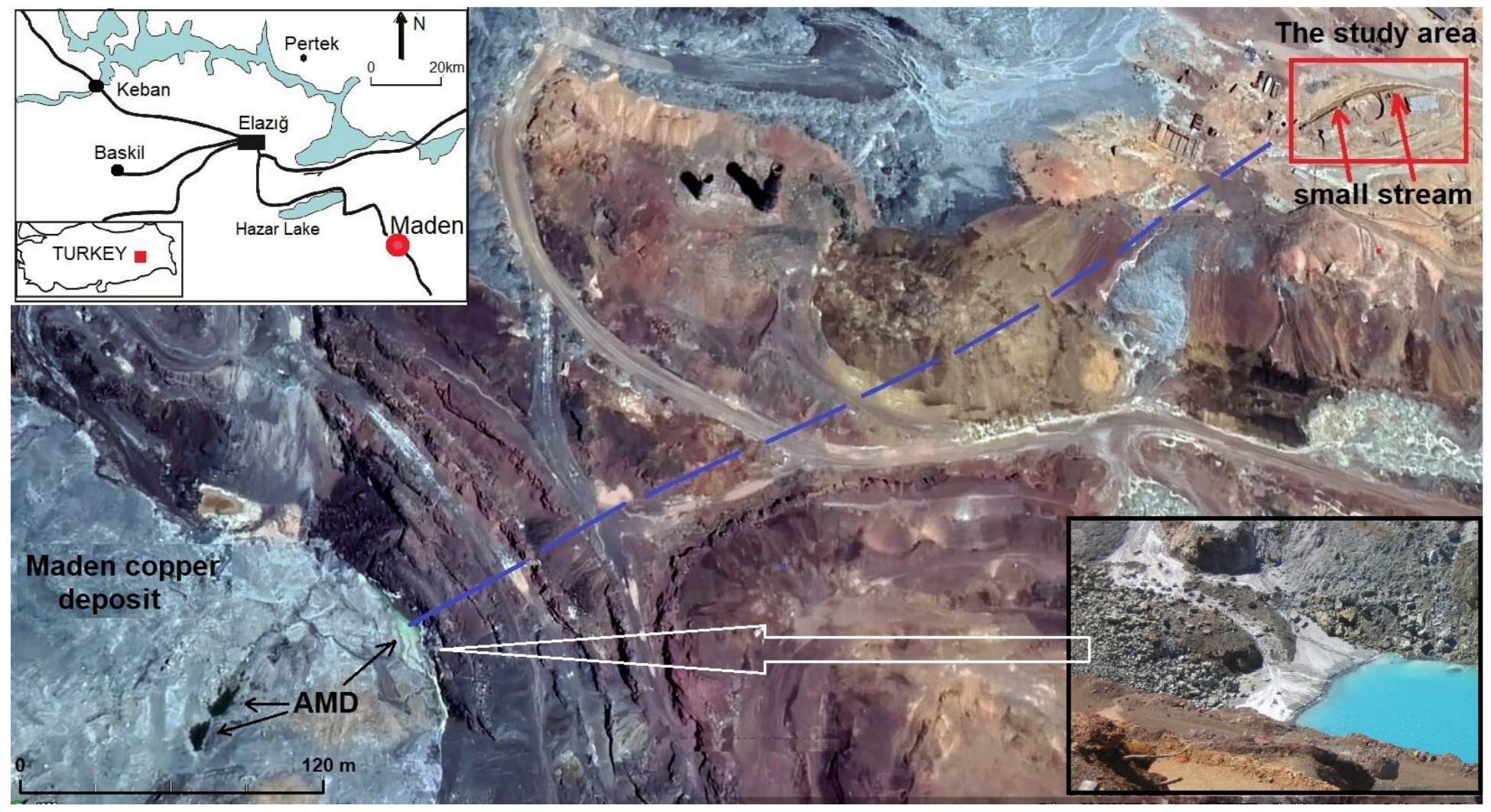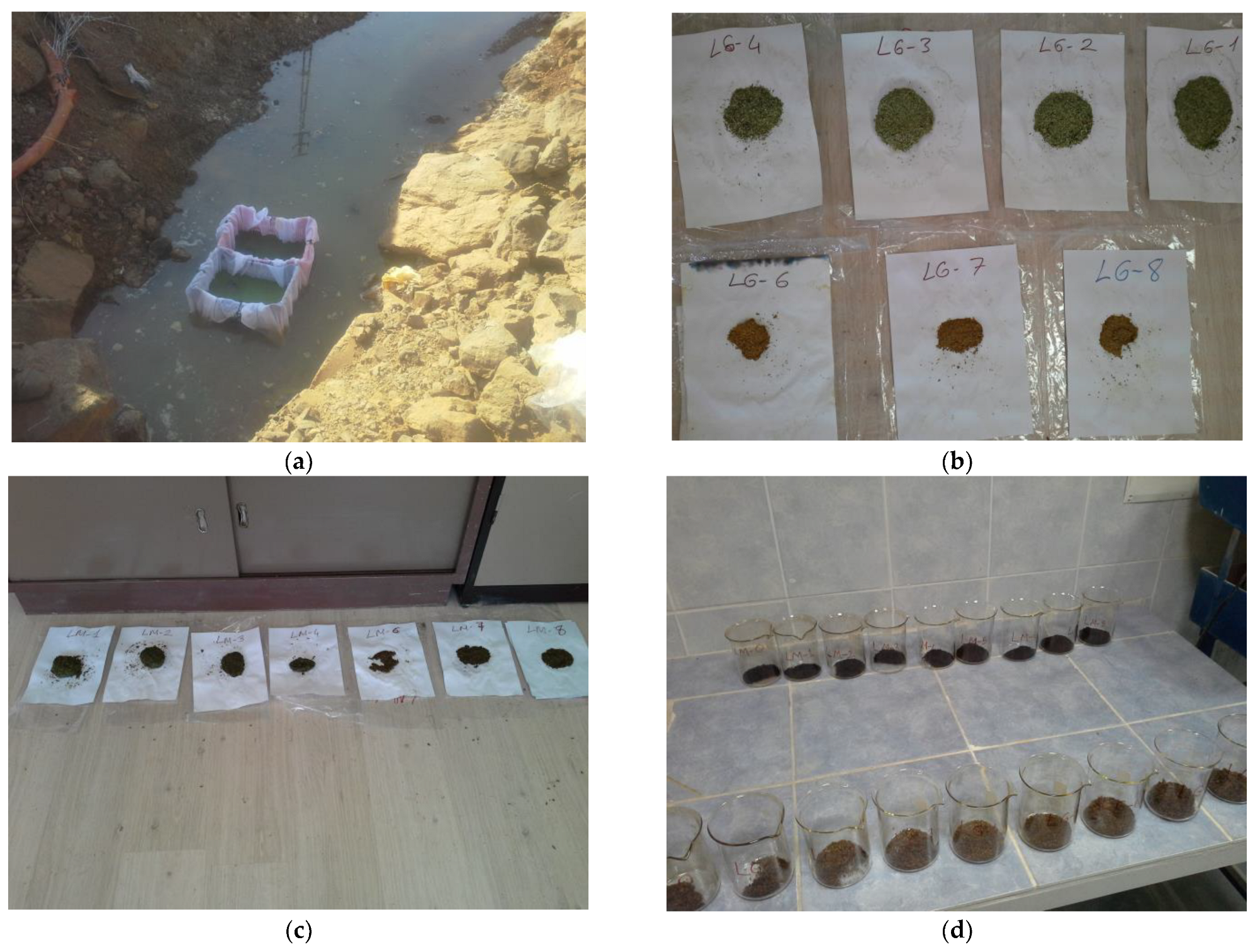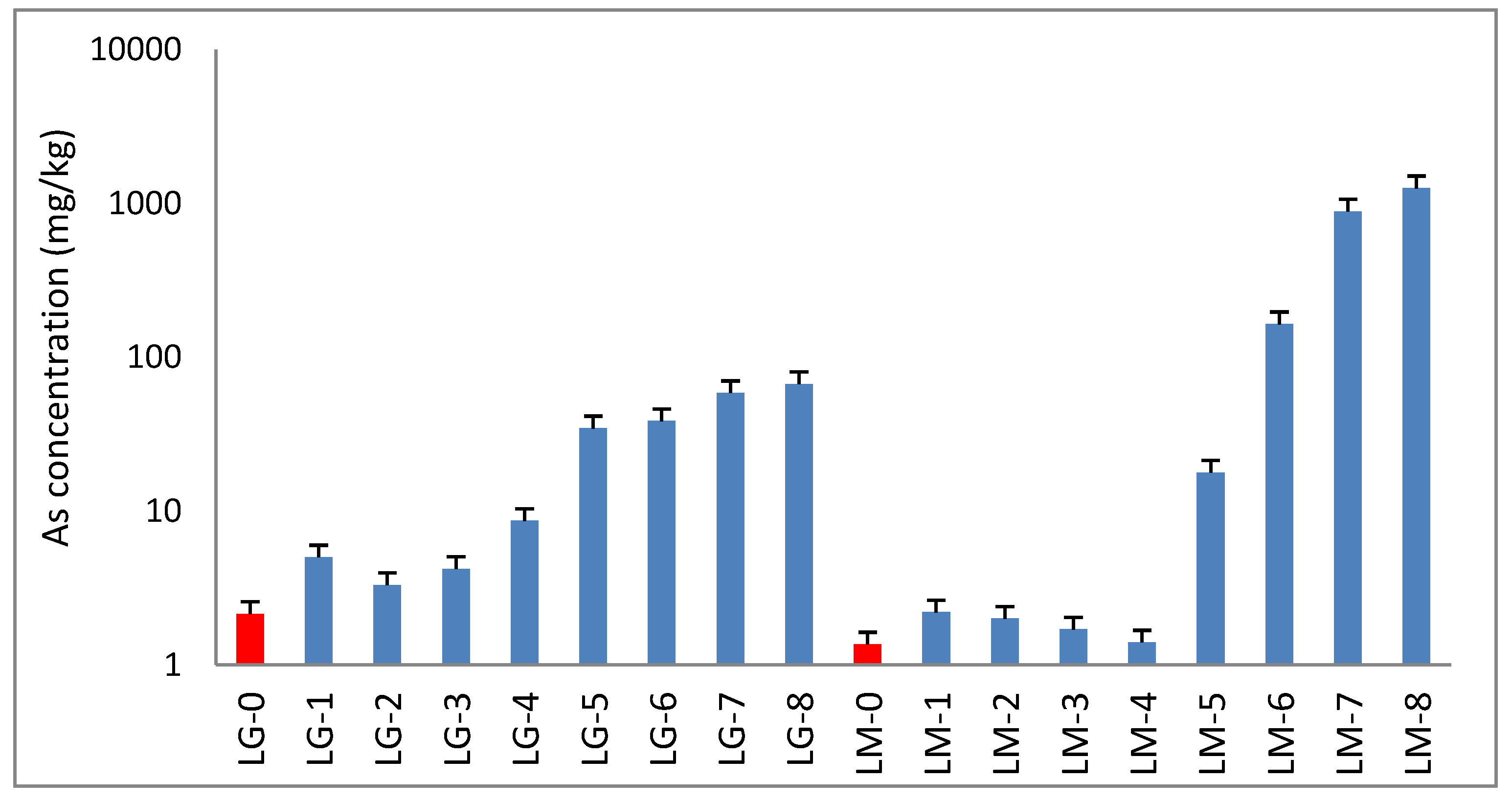Removal of Ag, Au, and As from Acid Mine Water Using Lemna gibba and Lemna minor—A Performance Analysis
Abstract
:1. Introduction
2. Material and Methods
2.1. The Study Area
2.2. Water and Plant Samples
2.3. Analytical Method
3. Results and Discussion
3.1. Ag, Au, and As in Acid Mine Water
3.2. Lemna minor and Lemna gibba
4. Conclusions
Funding
Data Availability Statement
Conflicts of Interest
References
- Wiessner, A.; Müller, J.A.; Kuschk, P. Environmental pollution by wastewater from brown coal processing—A remediation case study in Germany. J. Environ. Eng. Landsc. Manag. 2010, 22, 71–83. [Google Scholar] [CrossRef] [Green Version]
- Cesar Minga, J.; Elorza, F.J.; Rodriguez, R.; Iglesias, A.; Esenarro, D. Assessment of Water Resources Pollution Associated with Mining Activities in the Parac Subbasin of the Rimac River. Water 2023, 15, 965. [Google Scholar] [CrossRef]
- Tong, L.; Fan, R.; Yang, S.; Li, C. Development and status of the treatment technology for acid mine drainage. Min. Metall. Explor. 2021, 38, 315–327. [Google Scholar] [CrossRef]
- Lü, J.; An, Y. Hydrochemical Characteristics and Risk Assessment of Tongzi River, Guizhou Province, Southwest China. Water 2023, 15, 802. [Google Scholar] [CrossRef]
- Pan, Y.; Chen, M.; Wang, X.; Chen, Y.; Dong, K. Ecological Risk Assessment and Source Analysis of Heavy Metals in the Soils of a Lead-Zinc Mining Watershed Area. Water 2023, 15, 113. [Google Scholar] [CrossRef]
- He, X.W.; Li, F.Q. New technology and development tendency of mine water treatment. Coal Sci. Technol. 2010, 11, 17–22. [Google Scholar]
- Tchounwou, P.B.; Yedjou, C.G.; Patlolla, A.K.; Sutton, D.J. Heavy metals toxicity and the environment. In Molecular, Clinical and Environmental Toxicology; Springer: Basel, Switzerland, 2012; Volume 101, pp. 133–164. [Google Scholar]
- Gergen, I.; Harmanescu, M. Application of principal component analysis in the pollution assessment with heavy metals of vegetable food chain in the oldmining areas. Chem. Cent. J. 2012, 6, 56. [Google Scholar] [CrossRef] [PubMed] [Green Version]
- Rai, S.; Gupta, S.; Mittal, P.C. Dietary Intakes and Health Risk of Toxic and Essential Heavy Metals through the Food Chain in Agricultural, Industrial, and Coal Mining Areas of Northern India. Hum. Ecol. Risk Assess. Int. J. 2015, 21, 913–933. [Google Scholar] [CrossRef]
- Duffus, J.H. ‘‘Heavy Metals’’ A meaningless term? IUPAC (International Union of Pure Applied Chemistry). Pure Appl. Chem. 2002, 74, 793–807. [Google Scholar] [CrossRef] [Green Version]
- Goswami, C.; Majumder, A.; Misra, A.K.; Bandyopadhyay, K. Arsenic uptake by Lemna minor in hydroponic system. Int. J. Phytoremediation 2014, 16, 1221–1227. [Google Scholar] [CrossRef]
- Goswami, C.; Majumder, A. Potential of Lemna minor in Ni and Cr removal from aqueous solution. Pollution 2015, 1, 373–385. [Google Scholar]
- Abdel-Gawad, F.K.; Khalil, W.K.B.; Bassem, S.M.; Kumar, V.; Parisi, C.; Inglese, S.; Temraz, T.A.; Nassar, H.F.; Guerriero, G. The Duckweed, Lemna minor Modulates Heavy Metal-Induced Oxidative Stress in the Nile Tilapia, Oreochromis niloticus. Water 2020, 12, 2983. [Google Scholar] [CrossRef]
- Haffner, O.; Kučera, E.; Drahoš, P.; Cigánek, J.; Kozáková, A.; Urminská, B. Lemna minor Bioassay Evaluation Using Computer Image Analysis. Water 2020, 12, 2207. [Google Scholar] [CrossRef]
- Sasmaz, M.; Topal, E.I.A.; Obek, E.; Sasmaz, A. The potential of Lemna gibba L. and Lemna minor L. to remove Cu, Pb, Zn, and As in gallery water in a mining area in Keban, Turkey. J. Environ. Manag. 2015, 163, 246–253. [Google Scholar] [CrossRef]
- Tatar, S.Y.; Obek, E. Potential of Lemna gibba L. and Lemna minor L. for accumulation of Boron from secondary effluents. Ecol. Eng. 2014, 70, 332–336. [Google Scholar] [CrossRef]
- Sood, A.; Uniyal, P.L.; Prasanna, R.; Ahluwalia, A.S. Phytoremediation potential of aquatic macrophyte, Azolla. Ambio 2012, 41, 122–137. [Google Scholar] [CrossRef] [Green Version]
- Chaudhuri, D.; Majumder, A.; Misra, A.M.; Bandyopadhyay, K. Cadmium removal by Lemna minör and Spirodela polyrhiza. Int. J. Phytorem. 2014, 16, 1119–1132. [Google Scholar] [CrossRef] [PubMed]
- Obek, E. Bioaccumulation of heavy metals from the secondary treated municipal waste water by Lemna gibba. Fres. Environ. Bull. 2009, 18, 2159–2164. [Google Scholar]
- Sasmaz, A.; Obek, E. The accumulation of arsenic, uranium, and boron in Lemna gibba L. exposed to secondary effluents. Ecol. Eng. 2009, 35, 1564–1567. [Google Scholar] [CrossRef]
- Gerardo, R.; de Lima, I.P. Monitoring Duckweeds (Lemna minor) in Small Rivers Using Sentinel-2 Satellite Imagery: Application of Vegetation and Water Indices to the Lis River (Portugal). Water 2022, 14, 2284. [Google Scholar] [CrossRef]
- Li, S.X.; Feng-Ying, F.; Yang, H.; Jian-Cong, N. Thorough removal of inorganic and organic mercury from aqueous solutions by adsorption on Lemna minor powder. J. Hazard. Mater. 2011, 186, 423–429. [Google Scholar] [CrossRef]
- Dirilgen, N. Mercury and lead: Assessing the toxic effects on growth and metal accumulation by Lemna minor. Ecotoxicol. Environ. Saf. 2011, 74, 48–54. [Google Scholar] [CrossRef]
- Lobotková, M.; Hybská, H.; Samešová, D.; Turˇcániová, E.; Barnová, J.; Rétfalvi, T.; Krakovský, A.; Bad’o, F. Study of the Applicability of the Root Wastewater Treatment Plants with the Possibility of the Water Recirculation in Terms of the Surfactant Content. Water 2022, 14, 2817. [Google Scholar] [CrossRef]
- Khataee, A.; Movafeghi, A.; Torbati, S.; Salehi Lisar, S.; Zarei, M. Phytoremediation potential of duckweed (Lemna minor L.) in degradation of CI Acid Blue 92: Artificial neural network modeling. Ecotoxicol. Environ. Saf. 2012, 80, 291–298. [Google Scholar] [CrossRef]
- Materazzi, S.; Canepari, S.; Aquili, S. Monitoring heavy metal pollution by aquatic plants. Environ. Sci. Poll. Res. 2012, 19, 3292–3298. [Google Scholar] [CrossRef]
- Erler, A. The Hydrothermal Alteration around Madenköy-Siirt Massive Sulphide Deposit. Ph.D. Thesis, Middle East Technical University (METU), Ankara, Turkey, 1982; p. 131, Unpublished. [Google Scholar]
- Sasmaz, A.; Gumus, G.; Sagiroglu, A. A typical example of allochtonous Cyprus type copper mineralizations: Derdere mineralizations. Geol. Bull. Turkey 1999, 42, 105–117. [Google Scholar]
- Davis, P.H. Flora of Turkey and The East Aegean Island; Edinburgh University Press: Edinburgh, UK, 1984. [Google Scholar]
- Cabrera, L.I.; Salazar, G.A.; Chase, M.W.; Mayo, S.J.; Bogner, J.; Davila, P. Phylogenetic relationships of aroids and duckweeds (Araceae) inferred from coding and noncoding plastid DNA. Am. J. Bot. 2008, 95, 1153–1165. [Google Scholar] [CrossRef]
- Turck, D.; Bohn, T.; Castenmiller, J.; De Henauw, S.; Hirsch-Ernst, K.I.; Maciuk, A.; Mangelsdorf, I.; McArdle, H.J.; Knutsen, H.K.; EEFSA Panel on Nutrition, Novel Foods and Food Allergens (NDA); et al. Scientific Opinion on the safety of Lemna minorandLemna gibbawhole plant material as a novel food pursuant to Regulation (EU) 2015/2283. EFSA J. 2022, 20, 07598. [Google Scholar]
- Agency for Toxic Substances and Disease Registry (ATSDR). Toxicological Profile for Silver; ATSDR: Atlanta, Georgia, 1990. [Google Scholar]
- United States Environmental Protection Agency (US EPA). Ambient Water Quality Criteria for Silver; US EPA: Washington, DC, USA, 1980.
- World Health Organization (WHO). Guidelines for Drinking-Water Quality; World Health Organization: Geneva, Switzerland, 2006; p. 553.
- World Health Organization (WHO). Silver in Drinking-Water; World Health Organization: Geneva, Switzerland, 2021; p. 25.
- Kabata-Pendias, A. Trace Elements in Soils and Plants; CRC Press: Washington, DC, USA, 2011; p. 412. [Google Scholar]
- Dong, D.; Li, H.; Zhang, J.; Sun, L. Removal of heavy metals from mine water by cyanobacterial calcification. Min. Sci. Technol. 2010, 20, 566–570. [Google Scholar] [CrossRef]
- Caussy, D.; Gochfeld, M.; Gurzau, E. Lessons from case studies of metals: Investigating exposure bioavailability and risk. Ecotoxicol. Environ. Saf. 2003, 56, 45–51. [Google Scholar] [CrossRef] [PubMed]
- Ning, N.; Liyuan, Y.; Jirui, D.; Xugui, P. Heavy Metal Pollution in Surface Water of Linglong Gold Mining Area, China. Proc. Environ. Sci. 2011, 10, 914–917. [Google Scholar] [CrossRef] [Green Version]
- Flakova, R.; Ženisova, Z.; Krcmar, D.; Ondrelkova, I.; Sracek, O. Occurrence of antimony and arsenic at mining sites in slovakia: Implications for theır mobility. Carpathian J. Earth Environ. Sci. 2017, 12, 41–48. [Google Scholar]
- Bakhshinezhad, H.; Bakhtavar, E.; Afghan, A. Assessment of arsenic concentration along a surface water fow path from Zarshuran gold mine to the downstream residential area. Environ. Earth Sci. 2019, 78, 668. [Google Scholar] [CrossRef]
- Piper, A.M. A graphic procedure in the geochemical interpretation of water analyses. Eos Trans. Am. Geophys. Union 1944, 25, 914–923. [Google Scholar] [CrossRef]
- Pilon-Smits, E.A. Phytoremediation. Ann. Rev. Plant Biol. 2005, 56, 15–39. [Google Scholar] [CrossRef] [PubMed]
- Tangahu, B.V.; Abdullah, S.R.S.; Basri, H.; Idris, M.; Anuar, N.; Mukhlisin, M. A review on heavy metals (As, Pb, and Hg) uptake by plants through phytoremediation. Int. J. Chem. Eng. 2011, 939161. [Google Scholar] [CrossRef]
- Cenci, R.M. The use of aquatic moss (Fontinalis antipyretica) as monitor of contamination in standing and running waters: Limits and advantages. J. Limnol. 2000, 60, 53–61. [Google Scholar] [CrossRef]
- Baby, J.; Raj, J.; Biby, E.T.; Sankarganesh, P.; Jeevitha, M.V.; Ajisha, S.U.; Rajan, S.S. Toxic effect of heavy metals on aquatic environment. Int. J. Biol. Chem. Sci. 2010, 4, 939–952. [Google Scholar] [CrossRef] [Green Version]
- Sasmaz, A.; Obek, E. The accumulation of silver and gold in Lemna gibba exposed to secondary effluents. Chemie der Erde 2012, 72, 149–152. [Google Scholar] [CrossRef]
- Uysal, Y. Removal of chromium ions from wastewater by duckweed, Lemna minor L. by using a pilot system with continuous flow. J. Hazard. Mater 2013, 263, 486–492. [Google Scholar] [CrossRef]
- Abdallah, M.A. Phytoremediation of heavy metals from aqueous solutions by two aquatic macrophytes, Ceratophyllum demersum and Lemna gibba. Environ. Tech. 2012, 33, 1609–1614. [Google Scholar] [CrossRef] [PubMed]
- Ucuncu, E.; Tunca, E.; Fikirdeşici, S.; Özkan, A.D.; Altindag, A. Phytoremediation of Cu, Cr and Pb mixtures by Lemna minor. Bull. Environ. Contam. Toxicol. 2013, 91, 600–604. [Google Scholar] [CrossRef]
- Sasmaz, M.; Obek, E.; Sasmaz, A. The accumulation of La, Ce and Y by Lemna minor and Lemna gibba in the Keban gallery water, Elazig Turkey. Water Environ. J. 2018, 32, 75–83. [Google Scholar] [CrossRef]
- De Souza, T.D.; Borges, A.C.; Braga, A.F.; Veloso, R.W.; De Matos, A.T. Phytoremediation of arsenic-contaminated water by Lemna Valdiviana: An optimization study. Chemosphere 2019, 234, 402–408. [Google Scholar] [CrossRef]
- Leblebici, Z.; Kar, M.; Yalcin, V. Comparative study of Cd, Pb, andNi removal potential bySalvinia natans(L.) All. andLemna minorL.: Interactions with growth parameters. Rom. Biotech Lett. 2018, 23, 13235–13248. [Google Scholar]
- Amare, E.; Kebede, F.; Berihu, T.; Mulat, W. Field-based investigation on phytoremediation potentials of Lemna minor and Azolla filiculoidesin tropical, semiarid regions: Case of Ethiopia. Int. J. Phytoremediation 2018, 20, 965–972. [Google Scholar] [CrossRef] [PubMed]
- Tatar, S.; Obek, E.; Arslan Topal, E.I.; Topal, M. Uptake of some elements with aquatic plants exposed to the effluent of wastewater treatment plant. Pollution 2019, 5, 377–386. [Google Scholar]





| Parameter | T | pH | EC | HCO3− | NO3− | SO4 | F- | Ca | Mg | K | Na | Fe |
| (°C) | (mS cm−1) | (mgL−1) | (mgL−1) | (mgL−1) | (mgL−1) | (mgL−1) | (mgL−1) | (mgL−1) | (mgL−1) | (mgL−1) | ||
| DL | - | - | - | - | - | - | - | 0.05 | 0.05 | 0.05 | 0.05 | 10 |
| Mining water | 22.6 ± 1.6 | 5.76 ± 0.1 | 2.55 ± 0.2 | 282 ± 16 | 1.86 ± 0.06 | 128 ± 8 | 0.41 ± 0.1 | 482 ± 24 | 426 ± 18 | 5.80 ± 0.3 | 115± 6 | 118 ± 7 |
| Parameter | Mn | S | P | B | Zn | Cr | Ni | Co | Cu | Ag | Au | As |
| (mg L−1) | (mg L−1) | (μg L−1) | (μg L−1) | (μg L−1) | (μgL−1) | (μg L−1) | (μg L−1) | (μg L−1) | (μg L−1) | (μg L−1) | (μg L−1) | |
| DL | 0.05 | 1 | 10 | 5 | 0.5 | 0.5 | 0.2 | 0.02 | 0.02 | 0.05 | 0.05 | 0.5 |
| Mining water | 6.4 ± 0.3 | 670 ± 28 | 236 ± 12 | 850 ± 45 | 2852 ± 84 | 202 ± 16 | 965 ± 58 | 1766 ± 72 | 15,535 ± 322 | 9.25 ± 0.4 | 0.92 ± 0.02 | 193 ± 12 |
Disclaimer/Publisher’s Note: The statements, opinions and data contained in all publications are solely those of the individual author(s) and contributor(s) and not of MDPI and/or the editor(s). MDPI and/or the editor(s) disclaim responsibility for any injury to people or property resulting from any ideas, methods, instructions or products referred to in the content. |
© 2023 by the author. Licensee MDPI, Basel, Switzerland. This article is an open access article distributed under the terms and conditions of the Creative Commons Attribution (CC BY) license (https://creativecommons.org/licenses/by/4.0/).
Share and Cite
Sasmaz Kislioglu, M. Removal of Ag, Au, and As from Acid Mine Water Using Lemna gibba and Lemna minor—A Performance Analysis. Water 2023, 15, 1293. https://doi.org/10.3390/w15071293
Sasmaz Kislioglu M. Removal of Ag, Au, and As from Acid Mine Water Using Lemna gibba and Lemna minor—A Performance Analysis. Water. 2023; 15(7):1293. https://doi.org/10.3390/w15071293
Chicago/Turabian StyleSasmaz Kislioglu, Merve. 2023. "Removal of Ag, Au, and As from Acid Mine Water Using Lemna gibba and Lemna minor—A Performance Analysis" Water 15, no. 7: 1293. https://doi.org/10.3390/w15071293
APA StyleSasmaz Kislioglu, M. (2023). Removal of Ag, Au, and As from Acid Mine Water Using Lemna gibba and Lemna minor—A Performance Analysis. Water, 15(7), 1293. https://doi.org/10.3390/w15071293






